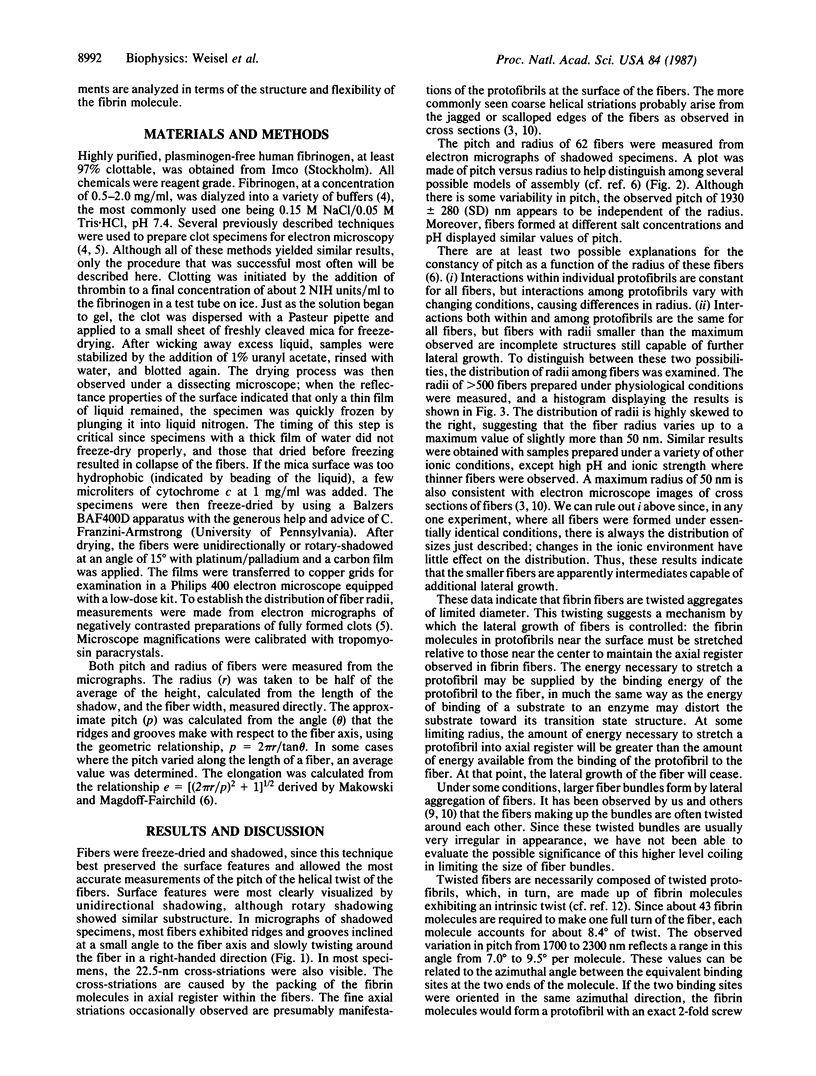Abstract
Electron microscopy of freeze-dried, shadowed fibrin fibers has demonstrated that these structures are twisted. The pitch and radius of many fibers were measured from the micrographs. Although there is some variability, the average pitch of 1930 +/- 280 (SD) nm is independent of radius. The distribution of observed radii of fibers assembled in vitro is highly skewed, suggesting that individual fibers grow to a maximum radius of about 50 nm, except when both pH and ionic strength are high; fibers aggregate to form thicker fiber bundles under some conditions. The observed twisting may be responsible for limiting the lateral growth of individual fibers. Protofibrils near the surface of a twisted fiber are stretched relative to those near the center. Consequently, the degree to which a protofibril can be stretched limits the radius of a fiber; protofibrils can be added to a growing fiber until the energy required to stretch an added protofibril exceeds the energy of binding. These properties of assembly arise directly from the intrinsic twist of the fibrinogen molecule determined from structural evidence. Simple geometric considerations lead to conclusions regarding the locations of the binding sites for assembly of the protofibril and the flexibility of the fibrin molecule.
Full text
PDF




Images in this article
Selected References
These references are in PubMed. This may not be the complete list of references from this article.
- Carrell N., Gabriel D. A., Blatt P. M., Carr M. E., McDonagh J. Hereditary dysfibrinogenemia in a patient with thrombotic disease. Blood. 1983 Aug;62(2):439–447. [PubMed] [Google Scholar]
- Chothia C., Lesk A. M., Dodson G. G., Hodgkin D. C. Transmission of conformational change in insulin. Nature. 1983 Apr 7;302(5908):500–505. doi: 10.1038/302500a0. [DOI] [PubMed] [Google Scholar]
- Gollwitzer R., Bode W., Schramm H. J., Typke D., Guckenberger R. Laser diffraction of oriented fibrinogen molecules. Ann N Y Acad Sci. 1983 Jun 27;408:214–225. doi: 10.1111/j.1749-6632.1983.tb23246.x. [DOI] [PubMed] [Google Scholar]
- Gollwitzer R., Bode W. X-ray crystallographic and biochemical characterization of single crystals formed by proteolytically modified human fibrinogen. Eur J Biochem. 1986 Jan 15;154(2):437–443. doi: 10.1111/j.1432-1033.1986.tb09416.x. [DOI] [PubMed] [Google Scholar]
- Hermans J. Models of fibrin. Proc Natl Acad Sci U S A. 1979 Mar;76(3):1189–1193. doi: 10.1073/pnas.76.3.1189. [DOI] [PMC free article] [PubMed] [Google Scholar]
- Hewat E. A., Tranqui L., Wade R. H. Electron microscope structural study of modified fibrin and a related modified fibrinogen aggregate. J Mol Biol. 1983 Oct 15;170(1):203–222. doi: 10.1016/s0022-2836(83)80233-2. [DOI] [PubMed] [Google Scholar]
- Krakow W., Endres G. F., Siegel B. M., Scheraga H. A. An electron microscopic investigation of the polymerization of bovine fibrin monomer. J Mol Biol. 1972 Oct 28;71(1):95–103. doi: 10.1016/0022-2836(72)90403-2. [DOI] [PubMed] [Google Scholar]
- Makowski L., Magdoff-Fairchild B. Polymorphism of sickle cell hemoglobin aggregates: structural basis for limited radial growth. Science. 1986 Dec 5;234(4781):1228–1231. doi: 10.1126/science.3775381. [DOI] [PubMed] [Google Scholar]
- Müller M. F., Ris H., Ferry J. D. Electron microscopy of fine fibrin clots and fine and coarse fibrin films. Observations of fibers in cross-section and in deformed states. J Mol Biol. 1984 Apr 5;174(2):369–384. doi: 10.1016/0022-2836(84)90343-7. [DOI] [PubMed] [Google Scholar]
- Tooney N. M., Cohen C. Crystalline states of a modified fibrinogen. J Mol Biol. 1977 Feb 25;110(2):363–385. doi: 10.1016/s0022-2836(77)80077-6. [DOI] [PubMed] [Google Scholar]
- Tooney N. M., Cohen C. Microcrystals of a modified fibrinogen. Nature. 1972 May 5;237(5349):23–25. doi: 10.1038/237023a0. [DOI] [PubMed] [Google Scholar]
- Voter W. A., Lucaveche C., Blaurock A. E., Erickson H. P. Lateral packing of protofibrils in fibrin fibers and fibrinogen polymers. Biopolymers. 1986 Dec;25(12):2359–2373. doi: 10.1002/bip.360251213. [DOI] [PubMed] [Google Scholar]
- Weisel J. W. Fibrin assembly. Lateral aggregation and the role of the two pairs of fibrinopeptides. Biophys J. 1986 Dec;50(6):1079–1093. doi: 10.1016/S0006-3495(86)83552-4. [DOI] [PMC free article] [PubMed] [Google Scholar]
- Weisel J. W., Phillips G. N., Jr, Cohen C. A model from electron microscopy for the molecular structure of fibrinogen and fibrin. Nature. 1981 Jan 22;289(5795):263–267. doi: 10.1038/289263a0. [DOI] [PubMed] [Google Scholar]
- Weisel J. W., Phillips G. N., Jr, Cohen C. The structure of fibrinogen and fibrin: II. Architecture of the fibrin clot. Ann N Y Acad Sci. 1983 Jun 27;408:367–379. doi: 10.1111/j.1749-6632.1983.tb23257.x. [DOI] [PubMed] [Google Scholar]
- Weisel J. W., Stauffacher C. V., Bullitt E., Cohen C. A model for fibrinogen: domains and sequence. Science. 1985 Dec 20;230(4732):1388–1391. doi: 10.1126/science.4071058. [DOI] [PubMed] [Google Scholar]
- Weisel J. W. The electron microscope band pattern of human fibrin: various stains, lateral order, and carbohydrate localization. J Ultrastruct Mol Struct Res. 1986 Jul-Sep;96(1-3):176–188. doi: 10.1016/0889-1605(86)90019-4. [DOI] [PubMed] [Google Scholar]
- Weisel J. W., Warren S. G., Cohen C. Crystals of modified fibrinogen: size, shape and packing of molecules. J Mol Biol. 1978 Dec 5;126(2):159–183. doi: 10.1016/0022-2836(78)90357-1. [DOI] [PubMed] [Google Scholar]
- Williams R. C. Morphology of fibrinogen monomers and of fibrin protofibrils. Ann N Y Acad Sci. 1983 Jun 27;408:180–193. doi: 10.1111/j.1749-6632.1983.tb23244.x. [DOI] [PubMed] [Google Scholar]




